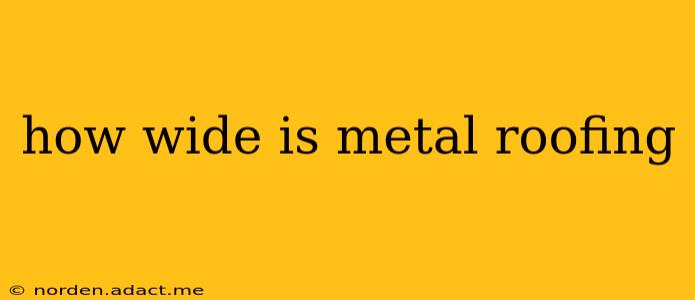Metal roofing offers durability, longevity, and aesthetic appeal, making it a popular choice for homeowners. However, one common question arises: how wide is metal roofing? The answer isn't a single number, as it varies considerably depending on the type of panel and the manufacturer. This comprehensive guide will delve into the specifics, helping you understand the different widths and factors influencing your choice.
What are the standard widths of metal roofing panels?
The width of metal roofing panels is usually described in two ways: nominal width and coverage width. The nominal width refers to the overall width of the panel before installation. The coverage width, on the other hand, represents the actual width of the roof covered after installation, considering overlaps. This overlap is crucial for ensuring watertightness and structural integrity.
You'll typically find metal roofing panels with nominal widths ranging from 24 inches to 48 inches. However, the exact dimensions can vary significantly between manufacturers and panel profiles. Always consult the manufacturer's specifications for precise measurements for your chosen product.
What factors influence metal roofing panel width?
Several factors influence the final width of your metal roofing:
-
Panel Profile: Different panel profiles (e.g., corrugated, ribbed, standing seam) have varying nominal widths. Standing seam panels often have a narrower coverage width due to the way the seams are interlocked. Ribbed panels, for instance, might have a greater coverage width due to their design.
-
Manufacturer: Each manufacturer may have slightly different dimensions for their panels, even if they have the same profile. It's essential to check the specifications provided by the specific manufacturer you're considering.
-
Gauge: The gauge (thickness) of the metal doesn't directly affect the width, but it influences the panel's overall strength and durability.
-
Installation Overlap: The overlap required during installation reduces the effective coverage width. This overlap is vital to ensure a watertight seal.
What is the coverage width of metal roofing?
The coverage width is consistently less than the nominal width due to the necessary overlap during installation. This overlap can vary depending on the panel type and manufacturer's recommendations but typically ranges from 1 to 3 inches. Therefore, while a panel might be nominally 36 inches wide, its actual coverage width might be closer to 33-35 inches. Remember to factor in this overlap when calculating the amount of roofing material you'll need for your project.
How do I calculate the amount of metal roofing needed?
Accurately calculating the amount of metal roofing you need is crucial to avoid shortages or unnecessary waste. Here's a simplified approach:
-
Measure your roof area: Carefully measure the length and width of each section of your roof.
-
Consider the coverage width: Use the coverage width provided by your chosen manufacturer, not the nominal width, to calculate the number of panels required for each row.
-
Account for waste: Add extra material to account for cuts, waste, and potential errors (typically 5-10%).
-
Consult a professional: It's always recommended to consult with a roofing professional for accurate calculations and to ensure proper installation. They can account for complex roof shapes and specific panel requirements.
How does metal roofing width impact installation?
The width of the metal roofing panels significantly impacts the installation process. Wider panels often mean fewer panels to install, potentially reducing labor costs and installation time. However, handling wider panels can be more challenging, requiring specialized equipment and experience for proper alignment and secure fastening.
What are common metal roofing panel sizes?
While there's no single "standard," some common nominal widths you’ll frequently encounter include 24 inches, 36 inches, and 48 inches. Remember, these are nominal widths, and the actual coverage width will be less due to overlaps.
By carefully considering the nominal width, coverage width, and the factors influencing them, you can select the right metal roofing for your project, ensuring a successful and aesthetically pleasing result. Always consult your chosen manufacturer’s specifications for the precise dimensions and installation recommendations.
